Optical Components for Expansive Lens Systems, including Domes and Diopters
In the captivating world of underwater photography, two essential accessories that play a significant role are dome ports and diopters.
Some underwater photographers prefer glass dome ports for their effect on underwater buoyancy and resistance to scratches. These ports, heavier than their acrylic counterparts, are valued for their durability and ability to shed water more easily for over-under shots.
When it comes to lens choices, the Angel shark photo you see here was taken with a Tokina 10-17mm fisheye lens, an acrylic S&S 6-inch dome port, and strobes out wide to ensure a sharp photo in the corners and rear of the fish. For rectilinear lenses, an 8-10 inch dome port is usually preferred, with performance being best at smaller apertures, such as F8 or smaller.
However, when a rectilinear wide-angle lens is used behind a dome port underwater, a diopter is often employed. A diopter primarily modifies the optical characteristics by shortening the minimum focusing distance, enabling closer focusing or better macro capability without changing the lens itself. This is valuable because wide-angle lenses typically have longer minimum focus distances that limit close-up details.
Using a diopter behind a dome port can influence the overall optical path. Dome ports restore the lens’s field of view underwater by compensating for refraction, but adding a diopter alters that correction. This can lead to slight changes in magnification and potential subtle distortions or shifts in focus plane, though preserving the rectilinear characteristics is generally still possible with good quality diopters.
In practical underwater photography workflows, diopters are often combined with macro or super-macro shooting and may be paired with additional filters or prisms externally applied to the port or diopter for fine-tuning optical effects. The impact varies depending on diopter strength and quality, as well as how well it aligns optically with the dome port’s curvature and the lens's design.
For optimal results with wide-angle lenses, align the base of the dome port with the 1st element of the lens using the appropriate extension ring. Lenses that don't focus close, like the Nikon 12-24mm or Nikon 17-35mm, require a diopter when used behind a dome port, while lenses that focus ten inches away or closer, like the Sigma 10-20mm or Nikon 10-24mm, generally don't need a diopter, especially when using an 8-inch dome port or larger.
It is also worth noting that the virtual image's distance from the dome port is closer for smaller dome ports. This can cause photos to be blurry if not properly accounted for. If you are using a compact camera, you may have to use macro mode with a dome port or your photos will be out of focus.
For the best underwater wide-angle optics with a rectilinear wide-angle lens, consider using a wide angle conversion port, a combination of a lens and a port developed by Nauticam.
When choosing between dome ports and diopters, it's essential to consider their impact on your photography, and the Nauticam WACP-1 and WACP-2, designed for 28mm and 14mm equivalent lenses respectively, are excellent options to explore. The housing manufacturer or housing dealer can usually recommend the proper extension/diopter combination for your dome port and lens.
- In underwater photography, a tutorial on the use of strobes can be helpful for achieving sharp photos in various corners of the subject, like the one seen with the Angel shark.
- Some photographers prefer compact glass dome ports for their resistance to scratches and improved water shedding ability, perfect for over-under shots.
- For macro photography underwater, the combination of a dome port and a diopter can significantly reduce the minimum focusing distance, allowing for detailed close-up shots.
- Underwater guidebooks suggest using bluewater as a backdrop for silhouette shots, creating a captivating contrast against the subject.
- Technology-loving photographers may find smartphone gadgets like underwater camera cases beneficial for capturing photos without the need for expensive gear.
- In terms of composition, an off-center silhouette can add a sense of mystery to an underwater wreck photograph.
- When shooting underwater, the color of the environment can greatly influence the mood of the image, making it essential to understand complementary and analogous color schemes.
- Using a wide-angle conversion port, like the Nauticam WACP-1, can help maximize the rectilinear characteristics of a wide-angle lens underwater.
- Photographers who venture into the world of underwater photography should explore various gadgets, from dome ports and diopters to macro filters and wide-angle conversion ports, to improve their craft and create stunning images.




